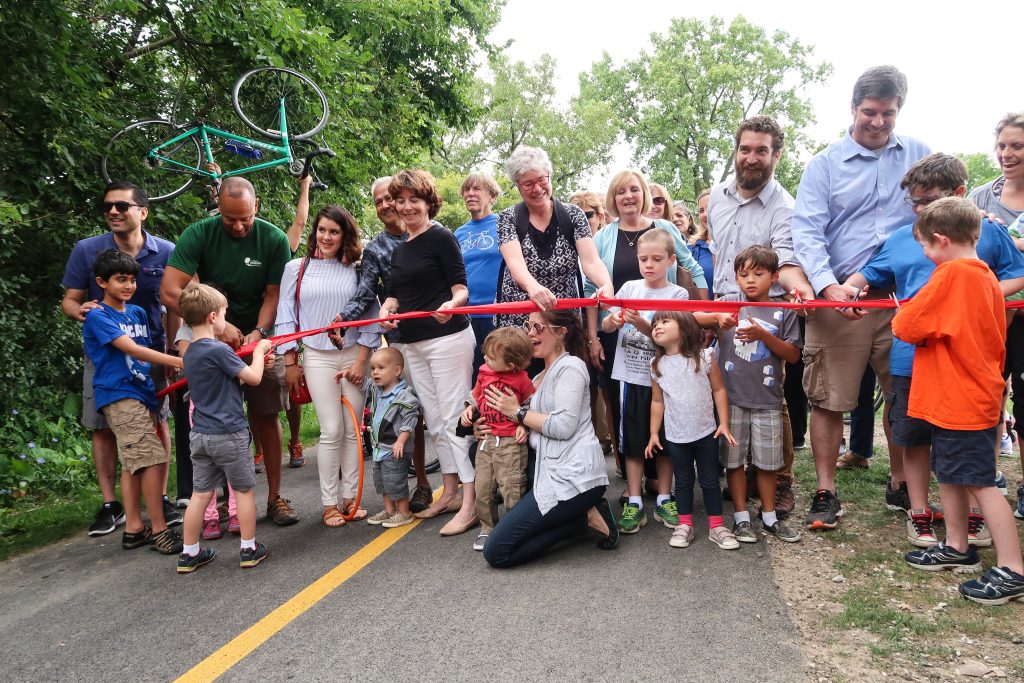The coming new year provides a moment to pause and reflect on the accomplishments of the past year. With that in mind, here is Active Transportation Alliance’s top ten list of active transportation stories from 2017.
As you browse through these, be sure to savor the successes — especially if you’re one of the many people who helped make them happen.
1. First sections of Lakefront trail separation open
Thanks to many years of advocacy and a $12 million donation from Ken Griffin, the Chicago Park District began building separate lakefront trails for people walking and people biking on all 18 miles of Chicago’s Lakefront Trail, with a goal of the completing the work by the end of 2018. Segments are complete on the North (Fullerton to Ohio Street) and South (35th to 55th Streets) Sides.
2. Progress made on Chicago River Trail
In line with our vision for a continuous Chicago River Trail, the city added several trail segments and moved forward with development concepts that improve biking and walking along the river. The North Branch Trail extension opened and construction began on the 312 RiverRun Trail.
3. CTA launches prepaid boarding pilots
Chicago expanded its prepaid boarding pilot program after data showed it sped up service along some of the city’s busiest bus routes. This is one of the key recommendations featured in Active Trans’ Back on the Bus report released this fall.
4. Bike lanes installed on Milwaukee Ave through Wicker Park
After hundreds of advocates turned out to public meetings, the city added bike infrastructure to one of the busiest biking corridors in the country while also creating more and safer spaces for people walking. This narrow section of Milwaukee Ave., with confusing 6-way intersections, is a hotspot for bike and pedestrian crashes. The dashed bike lanes are a good near-term solution until funding is available to add more permanent infrastructure, such as protected bike lanes.
5. Randolph protected bike lane adds to downtown network
The city installed a westbound protected bike lane on Randolph in the Loop as part of the Loop Link bus project, providing another strong link in the increasingly well-connected downtown protected bike lane network.
6. Chicago adds new 311 code for blocked bike lanes
People riding bikes can now easily report when vehicles are parked in bike lanes, and the city uses the information to identify hotspots and prioritize enforcement. Active Trans organized hundreds of supporters to submit photos of obstructions and shared them with the city, along with policy recommendations.
7. Chicago releases Vision Zero Action Plan
The three-year plan is a good start but will need to evolve, with the addition of citywide policy change and a dedicated Vision Zero Infrastructure Fund in the city budget, for Chicago to achieve the Vision Zero goal and make our streets safer for everyone, especially the most vulnerable people who are walking and biking. Another crucial aspect is getting meaningful community input from residents living in the high-crash areas that are prioritized in the plan, to ensure strategies are aligned with community needs.
8. Suburbs embrace action transportation plans and policies
Active Trans’ planning team finished 10 Complete Streets policies and 6 active transportation plans in suburban towns, the majority in low-income communities that traditionally can’t afford them. Active Trans also launched the Bike Walk Every Town campaign to recruit and train suburban advocates, hosting five regional summits with more than 100 participants from 60 suburbs.
9. Bus rapid transit project breaks ground in Gary
The City of Gary, Indiana began construction on a bus rapid transit corridor through downtown that will make the street more livable for everyone and aid economic development.
10. Chicago increases ride-hailing fee to pay for transit
The Chicago City Council increased the fee on Uber and Lyft trips and all the new revenue will go to public transit upgrades. Active Trans supported the fee increase amid concerns that the services are increasing congestion and contributing to declines in bus ridership.
Stay on top of the latest Active Trans news throughout the year by signing up for our monthly e-newsletter and join the fight by signing on to our advocacy supporter list.

